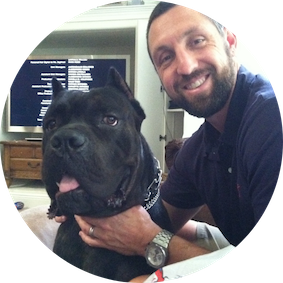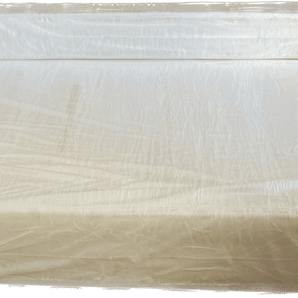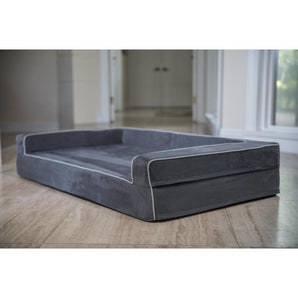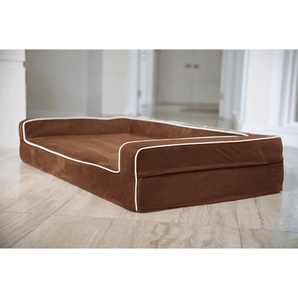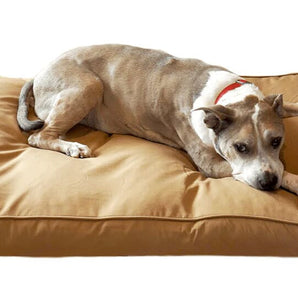Dogs are a valuable part of our families, so when they get injured, it's almost as hard on the pet owner as it is on the pup.
What do you do if your dog has a torn ACL? Is surgery necessary? What does recovery time look like? Will they have more problems in the future?
We're going to answer all of these questions and more in this complete guide to torn ACL in dogs.
Even if your dog doesn't have an injury right now, you should be prepared in case it happens to your four-legged family member.
We're going to go over what an ACL is, what a torn ACL means for a dog, the causes, symptoms, surgical options, recovery time, and other treatments. We'll also give you tons of vet-recommended remedies you can do at home to speed up your fur baby's recovery.
At the end of this guide, you'll know exactly what to do if your dog ever deals with a torn ACL.
Let's jump in.
What is the ACL?
ACL stands for the anterior cruciate ligament. Dog ACLs are just like human ACLs. It's a knee ligament that's attached to the back of the femur and the front of the tibia.
Your vet may also refer to the ACL as the CCL, which is the same ligament in dogs. CCL stands for cranial cruciate ligament, but vets commonly refer to it as the ACL since pet-owners are more familiar with that term.
How Does a Torn ACL in Dogs Happen?
Your dog can injure their ACL when they're jumping, running, or playing. For instance, a misstep when they're running at full force could cause the ACL to tear.
Some added risk factors make some dogs more likely to get injured, including:
- Obesity
- Genetics
- Size (more common in large dogs)
- Gender (more common for female dogs that are spayed)
- Golden Retrievers
- Labrador Retrievers
- German Shepherds
- Rottweilers
- Newfoundlands
- Neopolitan Mastiff's
- Akita's
- St. Bernard's
- Chesapeake Bay Retriever's
- American Staffordshire Terrier
If you suspect your dog is hurt, you should take him or her to the vet right away. An examination and x-rays will determine what kind of injury it is and how it needs to be treated.

What Are the Signs of a Torn ACL in Dogs?
The first sign that your dog has a torn ACL is a slight limp in the injured leg. As the tear gets worse, the limp will get worse too, and eventually, they may not be able to put weight on that leg.
Raising their leg in the air while they lay down could also be an indication that your dog is hurt. Swelling in the knee is another symptom and sign of a torn ACL.
If you notice any of these signs, take your dog to the vet as soon as you can. Catching a torn ACL injury before it progresses will help speed up their recovery so they and ease their pain faster.
An ACL injury will not heal on its own, so ignoring it will only prolong your dog's suffering.
Treatments for a Torn ACL in Dogs
The most common and effective treatment for a torn ACL in dogs is surgery. While you're waiting for the surgery date, you can do a couple of things to keep your dog more comfortable at home.
First, try to encourage your dog to rest as much as possible. They will likely be putting more weight on their other three legs, which isn't healthy in the long run.
You can get your dog an infrared orthopedic bed that will help relieve the pain from their torn ALC. The far infrared ray emission process helps increase blood flow, which aids in their recovery. The emissions are triggered by your dog's weight, so anytime he lays down on the bed it will send the infrared rays into his skin.
Next try to limit how much your dog jumps and climbs while they're injured. If you have stairs in your home, either carry them up and down, install a ramp, or just keep them on the first level of your home until they've recovered.
Now let's look at the different types of surgical options for your dog's torn ACL.
Types of ACL Surgeries for Dogs
Surgery is the best treatment for a torn ACL because it has the best outcome. After recovering from surgery, your dog will be able to be active and enjoy life again.
There are different types of ACL surgeries, and they differ in method, cost, and recovery time.
The first type is an extra-capsular repair, which is a complete ligament replacement. This is the most traditional and conservative surgical option, as well as the most cost-effective.
It will cost between $1200-2500, and the surgery involves replacing the torn ACL with a false ligament. This surgery is typically recommended for smaller dogs that weigh under 50 pounds, but it's often performed on larger breeds too.
The second type of ACL surgery is Tibial Plateau Leveling Osteotomy (TPLO). With this surgery, the tibia is cut and rotated into a flatter position to give the knee more stability. It's more complex than the ligament replacement, and it costs between $2400-4500.
Another surgical option is a tibial tuberosity advancement (TTA). A cut is placed in the front of the tibia so that a spacer can be placed inside of it. Then a metal plate is used to secure the bone. This surgery costs between $3500-4500.

Which Torn ACL Surgery is Best for My Dog?
The best surgical option for your dog will depend on the severity of their injury, breed, size, age, and overall health. All ACL surgeries have a track record of good results.
The ligament replacement is the most non-invasive option, which is great for small dogs and older dogs.
The TPLO surgery is a more effective long-term solution, so it's usually recommended for younger dogs who want to get back to their active lives. It provides stability for the joint almost immediately after surgery. Vets usually recommend this option for larger dogs too.
The TTA surgery is also extremely effective and has faster recovery times than the other options. However, it is the most expensive and sometimes puts dogs at a higher risk for a meniscal tear later on.
Talk to your vet about which option is right for your dog's injury. Keep in mind that all options require weeks of recovery where your dog can't be very active.
Let's dive into what recovery looks like next.
Healing Torn ACLs After Surgery
This part of the process is just as important as the surgery. If your dog doesn't take the full recovery time needed, it will increase its chances of getting injured again.
Your vet will give you all the info you need about your dog's recovery, but in general, it involves at least six weeks of rest so your dog doesn't put any strain on the site of the surgery.
Some dog owners choose to confine their dogs in their crates while they recover so they don't over-exert themselves. This will be hard, but it's extremely important that your dog fully recovers after surgery.
If you don't want to keep your dog in his or her crate, you can confine him or her to a small room instead. The room should have carpeted floor so your dog doesn't slip and injure themselves further. They also need comfortable bedding to cushion the joints.
Try to monitor your dog as much as possible. Even something as small as running to the front door to greet visitors can cause more damage to their ACL. The only activity they should have is leashed trips outside to go to the bathroom.
Don't let your dog climb stairs or jump on any furniture during their recovery period. They are on strict bed rest. The infrared orthopedic bed will come in handy during this time too. It will help relieve your dog's pain, and the heat also helps them sleep better.
Medications and Supplements
Your vet will also prescribe a non-steroid anti-inflammatory pain medication that you can give your dog to combat post-surgery soreness and speed their recovery.
There are also joint supplements that may promote your dog's joint health that you can give him during recovery; however, the research on their effectiveness is not conclusive.
Cold Compresses for Swelling
Post-surgery, the incision site may swell up and get bruised. You can hold a cold pack or washcloth to the area for five to ten minutes a few times a day to help the swelling go down.
Physical Therapy
Your vet may also recommend that your dog does physical therapy after the surgery. This will help the ligament rebuild strength and stability. It will also improve your dog's balance and tone of the muscle.
However, you should not start any physical therapy treatments until after the initial six weeks, or longer if your vet prescribes it, of recovery time.
Possible Post-Surgery Complications
You should be aware of the following post-surgery complications so you can avoid them or know how to treat them if they happen to your dog.
The first common complication is that the incision site gets infected.
This happens when your dog chews and licks the spot, so you must keep the Elizabethan collar, also known as the cone of shame, on them for their entire recovery. They won't like it, but it's necessary for their complete healing.
If the incision spot does get infected, call your vet immediately so they can give you medication.
If your dog's swelling is really large, there may be trapped blood or fluid under the skin. This typically occurs in dogs who are too active after their surgery. Call your vet immediately because it may require a minor operation to drain the fluid.
If your dog had the TPLO surgery, it's also possible that the metal plate can shift and fail if your dog is too active too soon. This is why following the post-surgery rest guidelines is so important. The last thing you want is for your dog to continue being in pain and for your money to go down the drain.
To avoid any other post-surgery complications, make sure you take your dog to all of the post-op check-ups that your vet requires. That way your vet will be able to catch any complications early and get your dog back on the journey to complete healing.

Reintroducing Physical Activity
At the beginning of their recovery, your dog should only be allowed outside on a leash to go to the bathroom. Keeping them on a leash will prevent them from exercising themselves or trying to play.
About two weeks after the surgery, you will take your dog back to the vet to have his staples removed from the incision. After this, the vet typically says you can increase physical activity to light walks around one block.
Swimming may also be allowed since it's a low-impact activity, but you should always follow your vet's guidance.
You can gradually increase the length of your walks as your dog recovers, but do not increase intensity yet. The knee needs time to strengthen again, and intense exercise can injure it again when it's still weak.
As you increase the length of your walks, monitor your dog's behavior. If he seems sore, take a break from going on walks for a few days and go back to shorter ones.
After several weeks of short walks, it may seem like your dog is completely healed and he may beg to have more activity. However, this is still a crucial time in the recovery process.
Do not speed it up just because your dog is behaving normally and seems better. Listen to all of your vet's recommendations and do not over-exert your dog before it's safe.
Avoid play dates with other dogs until your pup is completely healed. Otherwise, they may get too excited and hurt themselves.
Non-Surgical Treatment Options
Even though surgery is the best and most common way to treat a torn ACL, some other conservative treatments can help too. However, this is typically only recommended for smaller dogs. Larger dogs usually always need surgery because they have so much weight to put on their legs.
If your vet does recommend conservative treatment over surgery, it will usually be a combination of rest and medication to manage your dog's pain.
Your dog will likely need a six-week rest period that looks just like the surgery recovery period. You'll need to confine them to their crate or a room to minimize movement so that the ligament can form scar tissue that will help stabilize the knee.
Physical therapy sessions may also help your dog's recovery if they aren't having surgery.
Keep in mind that surgery is still the best option that gets your dog back to its active selves. It also decreases the chance of re-injuring the ACL, and after the initial recovery, they shouldn't deal with the pain anymore.
Future Health Risks After a Torn ACL
Unfortunately, once your dog has knee problems, their chances of having them again are higher. Along with re-injuring their original ACL tear, they're also at a higher risk of injuring the ACL on a different leg.
Another common complication that dogs with a torn ALC experience is arthritis.
You may not be able to completely prevent these complications, but you can lower your dog's risk. The main thing you need to do is watch your dog's weight.
When your dog is overweight, the likelihood that they'll deal with another injury or develop arthritis skyrockets. Feed your dog the proper amount of high-quality food, and don't feed them human food.
If your dog needs to go up and down stairs or gets on the couch or bed with you, consider getting ramps so he doesn't have to jump up and down so much. You should also limit activities like fetch that make your dog accelerate, stop, and change directions quickly.
You can also continue giving your dog joint supplements for dogs to keep them healthy and keep using the infrared orthopedic bed to soothe any joint issues and pain they face.
Preventing Torn ACLs in Dogs
The main way to prevent a torn ACL in the first place is to keep your dog slim and healthy. Obesity increases the risk of many common dog injuries, so make sure they eat a healthy diet and get enough exercise for their size and breed.
Other Common Dog Injuries
Here are a few other common dog injuries you should know about so you can identify them if they ever happen to your dog:
Foreign body ingestion: if your dog consumes something they shouldn't it could cause damage to their internal organs. Make sure all of your dog's toys are too big to swallow. If he starts throwing up or isn't interested in food, those are signs that he may have eaten something he can't pass. Call your vet immediately.
Eye trauma: corneal scratches, ulcers, and perforations are all things to look out for. Watch for excessive tearing or blinking.
Back problems: most common in small dogs with long backs like dachshunds, basset hounds, and corgis. Try to limit how much they jump on and off furniture and manage their weight.
Read about more common pet injuries here.
The Infrared Dog Bed
If you want the best for your dog, whether or not they are injured, you should get them the infrared orthopedic dog bed from Bully Beds -- the first and only dog bed that has FDA medical device certification.
It's amazing for your dog's joints and bones, and it's also the height of luxury. It's made in the USA, waterproof, washable, and built to last for years.
The infrared orthopedic dog bed is proven to be beneficial for your dog's hips, joints, elbows, and whole body. When your dog lays on the bed, the advanced ceramic-coated fibers reflect the far-infrared ray emissions that naturally occur from your dog's body heat back into his skin.
The rays dilate blood vessels, which increases circulation and enhances tissue oxygen levels. They help with deep tissue recovery, which gives your dog more energy, reduces their recovery time, and eases pain.

The bed also provides a level of thermal regulation. That means it helps regulate your dog's body temperature as they sleep so they sleep cooler.
The bed is ideal for large breed dogs who are more prone to joint issues. It comes in sizes large, extra-large, and XXL.
Your pup will love stretching out on this comfy bed, and it will also keep them extremely comfortable during their recovery period in confinement.
All Bully Beds also come with a 20-year warranty, so your dog can use it for years even after they recover from their injury or surgery.
Keeping Your Dog Safe and Healthy
We only want the best for our dogs, and it's heartbreaking to see them in pain. Follow the prevention methods we recommended in this guide to reduce the risk of torn ACL in dogs. Especially be sure watch your dog's weight and make sure they get enough exercise.
If they do get an ACL injury, talk to your vet about surgery options or non-surgical treatments immediately. After the surgery, be very vigilant about your dog's recovery. It will be hard, but it's the best way to ensure they can get back to their regular active life.
Lastly, make your dog is as comfortable as they can be at home with the infrared orthopedic dog bed from Bully Bed. Your dog will love it and it will be so encouraging to watch them recover faster thanks to the powerful infrared rays.
Check out reviews for the infrared orthopedic Bully Bed here, and shop our dog products on our websites today to give your dog the best.

